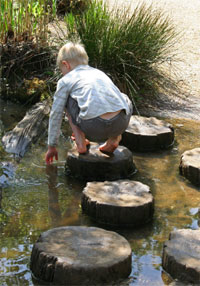Pond dipping

Pond dipping is a popular activity for children to participate in both in their own leisure time and as an educational activity, it is a low risk activity with high benefits. This information sheet is provides some tips for site managers and teachers or those in charge of taking children pond dipping as an educational activity.
Child pond safety
Children who are pond dipping are usually older than the key at-risk age of drowning in ponds. Children aged between one and two are particularly at risk of drowning in ponds. As the child increases in age, the risk decreases.
Even the shallowest of ponds can be lethal - from a child's perspective, a 500mm deep pond is equivalent to an adult falling into 1800mm of water – the child being unable to climb out of the water.
School wildlife ponds and the management of pond dipping
Schools have a duty of care towards their staff, pupils and other who may be on their premises. A school is required to carry out a risk assessment and implement reasonably practicable measures to ensure an acceptable level of safety. When considering safety issues, and in particular the risk of drowning in a school pond, there are a number of factors to assess.
What are the hazards?
- Unsupervised access to the pond, particularly by younger children.
- The water as a drowning hazard.
- Water quality and associated health hazards such as leptospirosis and the effects of blue-green algae.
- Interaction of the water with features such as steep banks, silt, and overhanging branches.
- The prevention of slips, trips and falls should be considered, and hygiene issues such as the small risk of Weil's disease and other water borne causes of ill health.
Who might be harmed?
- Young children, particularly under fives
- Teenagers (peer pressure often leads to risk taking)
- Staff and lone workers
- Children with special needs
- Members of the local community
- The elderly
Evaluate the level of risk
Decide whether existing precautions are sufficient, or whether more can be done. Assess factors such as function, location, depth, edge gradients, supervision, user groups, information provision, effects of weather i.e. ice, summer swimming.
Record findings and policies
- Create normal operating policies which detail how the pond is operated, the measures which have, or not, been implemented, and the reasoning behind any decision.
- Create an emergency action plan. This should be distributed to all staff, to let them know what to do on the event of an accident.
Monitor and review
The safety policy should be monitored, as should the pond itself e.g. if signage is damaged, it must be replaced, and user behaviour should be monitored and the operating procedures altered accordingly. The same principles should be applied to the assessment of pond dipping activities organised by schools. Reach poles, details of the risk assessment, and emergency action plans should be available to teachers supervising the activity.
Methods of risk control
Every pond and every school will be different, therefore overall guidance cannot be given, and this is why individual site-based risk assessments are required. However, in most circumstances, the following will apply:
- Access should be controlled and the pond effectively closed when not in use. This may be done with fencing, or vegetative barriers, or for smaller ponds, steel, rigid mesh fixed over the top of the pond. Fencing should be 1.1 metres high, with either 100mm spaced vertical bars, or steel mesh with an aperture of 25mm x 25mm.
- Pupils should be supervised – the ratio of adults to children should be such that each adult can easily supervise those they are responsible for.
- During the activity try to ensure that those children with cuts on their hands cover them with waterproof plasters or wear suitable gloves, avoid ingestion of water and ensure that all children wash their hands after the activity especially before eating.
- Edges that are open for access for pond dipping should be gently sloping, or flat and well defined. Where access is not required, or where the edge is steep, a protective barrier either in the form of marginal aquatic vegetation or fencing may be required.
- Clear signage should be used at the access points to the pond. For example, a sign stating 'No unaccompanied children', or, if ice forms during the winter 'Danger: thin ice'.
- Children and adults should wear appropriate footwear.
- For ponds, which are too deep for an adult to perform a wading rescue, suitable rescue equipment such as a reach pole, or a throw line should be provided.
- Any adult acting in a supervisory role should have read the operating policy and the emergency action plan. Training should include the opportunity to use rescue equipment. Ideally they should be aware of how to implement first aid.
Further information and resources
- 'Be Water Wise' - RoSPA have produced a simple easy to read leaflet for parents and teachers which explains the 'Be Water Wise' code and highlights the dangers presented by water and ice. These can be ordered in packs of 10.
- Leptospirosis Information Sheet
- BSI Water Safety Signage Standard ( PDF format 253kb) - Site managers can find out more information about the BS5499: 2002 Part 11 Water Safety Signs.